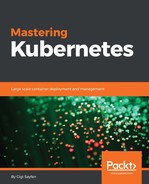- Mastering Kubernetes
- Table of Contents
- Mastering Kubernetes
- Credits
- About the Author
- About the Reviewer
- www.PacktPub.com
- Customer Feedback
- Preface
- 1. Understanding Kubernetes Architecture
- 2. Creating Kubernetes Clusters
- 3. Monitoring, Logging, and Troubleshooting
- 4. High Availability and Reliability
- High-availability concepts
- High-availability best practices
- Live cluster upgrades
- Large-cluster performance, cost, and design trade-offs
- Summary
- 5. Configuring Kubernetes Security, Limits, and Accounts
- 6. Using Critical Kubernetes Resources
- Designing the Hue platform
- Using Kubernetes to build the Hue platform
- Separating internal and external services
- Using namespace to limit access
- Launching jobs
- Kubectl get pods
- Mixing non-cluster components
- Employing init containers for orderly pod bring-up
- Evolving the Hue platform with Kubernetes
- Summary
- 7. Handling Kubernetes Storage
- Persistent volumes walkthrough
- Public storage volume types - GCE, AWS, and Azure
- GlusterFS and Ceph volumes in Kubernetes
- Flocker as a clustered container data volume manager
- Integrating enterprise storage into Kubernetes
- Summary
- 8. Running Stateful Applications with Kubernetes
- Stateful versus stateless applications in Kubernetes
- Shared environment variables versus DNS records for discovery
- Running a Cassandra cluster in Kubernetes
- Summary
- 9. Rolling Updates, Scalability, and Quotas
- Horizontal pod autoscaling
- Performing rolling updates with autoscaling
- Handling scarce resources with limits and quotas
- Choosing and managing the cluster capacity
- Pushing the envelope with Kubernetes
- Summary
- 10. Advanced Kubernetes Networking
- Understanding the Kubernetes networking model
- Kubernetes networking solutions
- Using network policies effectively
- Load balancing options
- Writing your own CNI plugin
- Summary
- 11. Running Kubernetes on Multiple Clouds and Cluster Federation
- Understanding cluster federation
- Managing a Kubernetes cluster federation
- Setting up cluster federation from the ground up
- Initial setup
- Using the official hyperkube image
- Running the federation control plane
- Registering Kubernetes clusters with federation
- Updating KubeDNS
- Shutting down the federation
- Setting up cluster federation with Kubefed
- Running federated workloads
- Summary
- 12. Customizing Kubernetes - API and Plugins
- Working with the Kubernetes API
- Extending the Kubernetes API
- Writing Kubernetes plugins
- Writing an authorization plugin
- Summary
- 13. Handling the Kubernetes Package Manager
- 14. The Future of Kubernetes
- Index
In this chapter, we got into some hands-on cluster creation. We created a single-node cluster using Minikube and a multi-node cluster using kubeadm. Then we looked at the many options to create Kubernetes clusters on cloud providers. Finally, we touched on the complexities of creating Kubernetes clusters on bare metal. The current state of affairs is very dynamic. The basic components are changing rapidly, the tooling is still young, and there are different options for each environment. It's not completely trivial to stand up a Kubernetes cluster, but with some effort and attention to detail you can get it done quickly.
In Chapter 3, we will explore the important topics of Monitoring, Logging, and Troubleshooting. Once your cluster is up and running and you start deploying workloads, you need you make sure it runs properly and satisfies requirements. This requires ongoing attention and responding to various failures that happen in the real world.
-
No Comment
